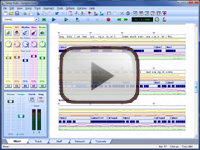(4.1) Major Scale Revisited
Recall that the series of semitone intervals that defines the Major scale is 2-2-1-2-2-2-1.
This is illustrated graphically below, together with an example of the notes in the C Major scale. All of the other scale types introduced in this tutorial will be shown in the same format, to make comparison easier.

The numbers 1 to 7 in the box above are the degrees of the Major scale which, as with chords, are a shorthand way of expressing the intervals relative to the root note.
The small 1 at the end of the list of degrees indicates the root note at the end of the scale, one octave up. By convention, scales usually end with a repeat of the starting note, although it is not necessary for defining the scale.
The dominance of the Major scale means that its degrees are a convenient benchmark for describing the intervals in all of the other scale types.
As you will see, the degrees of the other scale types have sharps and flats added to indicate how their intervals compare to the Major scale. For the degrees of the Major scale itself, of course, no sharps or flats are used.
Staff notation and the key signatures we have looked at previously are also firmly based on the Major scale.
When music using other scale types is written in staff notation, it often contains many accidental notes, because they do not align completely with the notes of the Major scale. You will see examples of this as we proceed.
|
Topic 47 of 117
| ||
Bring these music concepts to life with the free Songtrix Bronze Edition as you create songs from chords and scales.
Then publish and share your ideas with the other musicians you meet on the ChordWizard Network.
Have questions? Join the ChordWizard Network and post them in the Music Theory forum for answers and discussions on your topics of interest.








